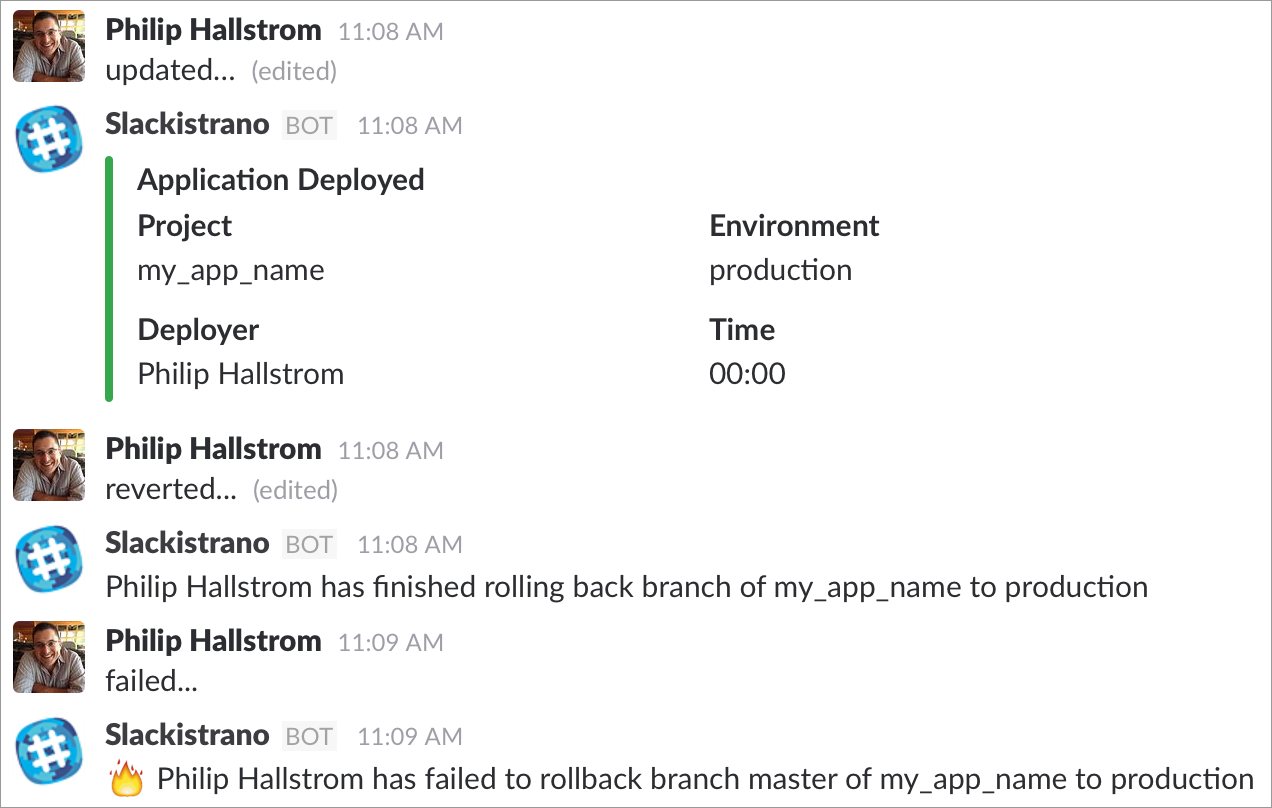https://github.com/phallstrom/slackistrano
Slack integration for Capistrano deployments.
https://github.com/phallstrom/slackistrano
capistrano ruby slack
Last synced: 7 months ago
JSON representation
Slack integration for Capistrano deployments.
- Host: GitHub
- URL: https://github.com/phallstrom/slackistrano
- Owner: phallstrom
- License: mit
- Created: 2013-12-20T19:53:56.000Z (almost 12 years ago)
- Default Branch: master
- Last Pushed: 2024-12-12T00:03:48.000Z (12 months ago)
- Last Synced: 2025-05-11T02:55:43.310Z (7 months ago)
- Topics: capistrano, ruby, slack
- Language: Ruby
- Size: 664 KB
- Stars: 372
- Watchers: 9
- Forks: 74
- Open Issues: 11
-
Metadata Files:
- Readme: README.md
- Changelog: CHANGELOG.md
- License: LICENSE.txt
Awesome Lists containing this project
README
# Slackistrano
[](http://badge.fury.io/rb/slackistrano)
[](https://codeclimate.com/github/phallstrom/slackistrano)
[](https://travis-ci.org/phallstrom/slackistrano)
Send notifications to [Slack](https://slack.com) about [Capistrano](http://www.capistranorb.com) deployments.
## Requirements
- Capistrano >= 3.8.1
- Ruby >= 2.0
- A Slack account
## Installation
1. Add this line to your application's Gemfile:
```ruby
gem 'slackistrano'
```
2. Execute:
```
$ bundle
```
3. Require the library in your application's Capfile:
```ruby
require 'slackistrano/capistrano'
```
## Configuration
You have two options to notify a channel in Slack when you deploy:
1. Using *Incoming WebHooks* integration, offering more options but requires
one of the five free integrations. This option provides more messaging
flexibility.
2. Using *Slackbot*, which will not use one of the five free integrations.
### Incoming Webhook
1. Configure your Slack's Incoming Webhook.
2. Add the following to `config/deploy.rb`:
```ruby
set :slackistrano, {
channel: '#your-channel',
webhook: 'your-incoming-webhook-url'
}
```
### Slackbot
1. Configure your Slack's Slackbot (not Bot).
2. Add the following to `config/deploy.rb`:
```ruby
set :slackistrano, {
channel: '#your-channel',
team: 'your-team-name',
token: 'your-token'
}
```
### Optional Configuration & Overrides
By default Slackistrano will use a default icon and username. These, can be
overriden if you are using the default messaging class (ie. have not specified
your own).
1. Configure per instructions above.
2. Add the following to `config/deploy.rb`:
```ruby
set :slackistrano, {
...
username: 'Foobar the Deployer',
icon_emoji: ':thumbsup:', # takes precedence over icon_url
icon_url: 'https://avatars2.githubusercontent.com/u/16705?v=4&s=40',
...
}
```
### Test your Configuration
Test your setup by running the following command. This will post each stage's
message to Slack in turn.
```
$ cap production slack:deploy:test
```
## Usage
Deploy your application like normal and you should see messages in the channel
you specified.
## Customizing the hooks
If you wish to take control over when and what slackistrano hooks are fired, then you can use the option in `deploy.rb`:
```ruby
set :use_custom_slackistrano_hooks, true
```
This allows you to set custom hooks for all the slackistrano tasks:
```ruby
'slack:deploy:starting'
'slack:deploy:updating'
'slack:deploy:reverting'
'slack:deploy:updated'
'slack:deploy:reverted'
'slack:deploy:failed'
```
## Customizing the Messaging
You can customize the messaging posted to Slack by providing your own messaging
class and overriding several methods. Here is one example:
```ruby
if defined?(Slackistrano::Messaging)
module Slackistrano
class CustomMessaging < Messaging::Base
# Send failed message to #ops. Send all other messages to default channels.
# The #ops channel must exist prior.
def channels_for(action)
if action == :failed
"#ops"
else
super
end
end
# Suppress starting message.
def payload_for_starting
nil
end
# Suppress updating message.
def payload_for_updating
nil
end
# Suppress reverting message.
def payload_for_reverting
nil
end
# Fancy updated message.
# See https://api.slack.com/docs/message-attachments
def payload_for_updated
{
attachments: [{
color: 'good',
title: 'Integrations Application Deployed :boom::bangbang:',
fields: [{
title: 'Environment',
value: stage,
short: true
}, {
title: 'Branch',
value: branch,
short: true
}, {
title: 'Deployer',
value: deployer,
short: true
}, {
title: 'Time',
value: elapsed_time,
short: true
}],
fallback: super[:text]
}],
text: " Application Deployed!"
}
end
# Default reverted message. Alternatively simply do not redefine this
# method.
def payload_for_reverted
super
end
# Slightly tweaked failed message.
# See https://api.slack.com/docs/message-formatting
def payload_for_failed
payload = super
payload[:text] = "OMG :fire: #{payload[:text]}"
payload
end
# Override the deployer helper to pull the best name available (git, password file, env vars).
# See https://github.com/phallstrom/slackistrano/blob/master/lib/slackistrano/messaging/helpers.rb
def deployer
name = `git config user.name`.strip
name = nil if name.empty?
name ||= Etc.getpwnam(ENV['USER']).gecos || ENV['USER'] || ENV['USERNAME']
name
end
end
end
end
```
The output would look like this:

To set this up:
1. Add the above class to your app, for example `lib/custom_messaging.rb`.
2. Require the library after the requiring of Slackistrano in your application's Capfile.
```ruby
require_relative 'lib/custom_messaging'
```
3. Update the `slackistrano` configuration in `config/deploy.rb` and add the `klass` option.
```ruby
set :slackistrano, {
klass: Slackistrano::CustomMessaging,
channel: '#your-channel',
webhook: 'your-incoming-webhook-url'
}
```
4. If you come up with something that you think others would enjoy submit it as
an issue along with a screenshot of the output from `cap production
slack:deploy:test` and I'll add it to the Wiki.
## Disabling posting to Slack
You can disable deployment notifications to a specific stage by setting the `:slackistrano`
configuration variable to `false` instead of actual settings.
```ruby
set :slackistrano, false
```
## TODO
- Notify about incorrect configuration settings.
## Contributing
1. Fork it
2. Create your feature branch (`git checkout -b my-new-feature`)
3. Commit your changes (`git commit -am 'Add some feature'`)
4. Push to the branch (`git push origin my-new-feature`)
5. Create new Pull Request